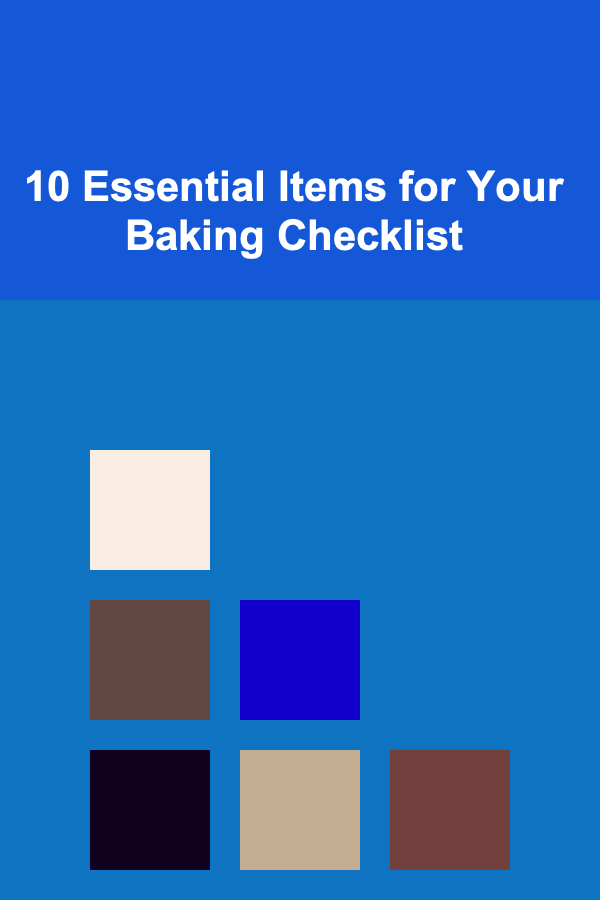
10 Essential Items for Your Baking Checklist
ebook include PDF & Audio bundle (Micro Guide)
$12.99$8.99
Limited Time Offer! Order within the next:

Baking is both an art and a science. Whether you're a novice or an experienced baker, having the right tools and ingredients can make all the difference between a successful bake and a kitchen disaster. While the world of baking is vast and full of possibilities, certain essentials are a must-have in every baker's kitchen to ensure that your creations come out perfectly every time.
In this article, we'll take you through ten essential items that should be included in your baking checklist. From basic ingredients to useful tools, these items will set you up for success in the kitchen.
High-Quality Flour
Flour is the backbone of almost every baked good, from cakes and cookies to bread and pastries. The quality of flour you use can greatly impact the texture, structure, and overall outcome of your baked goods. Different types of flour are suited for different purposes, so it's important to understand which one you need for your specific recipes.
Why It Matters:
- All-Purpose Flour is versatile and can be used in most recipes.
- Cake Flour has a finer texture and lower protein content, ideal for light, airy cakes.
- Bread Flour contains more protein, helping to develop the gluten structure in bread and other yeast-based goods.
- Whole Wheat Flour adds a denser texture and more fiber, but can make the dough heavier.
How to Choose:
When purchasing flour, ensure it's fresh and stored properly to avoid spoilage. Flour should be kept in an airtight container in a cool, dry place.
Baking Powder and Baking Soda
These two leavening agents are often used interchangeably in recipes, but they serve different purposes. Understanding when to use baking powder and when to use baking soda is crucial for getting the right rise and texture in your bakes.
Why It Matters:
- Baking Powder is a complete leavening agent, containing both an acid and a base, which releases carbon dioxide when mixed with liquid, helping your dough rise.
- Baking Soda is a base that requires an acidic ingredient (like vinegar, buttermilk, or lemon juice) to activate and produce gas bubbles.
How to Choose:
Make sure to check the expiration dates of both baking powder and baking soda. Freshness is key for achieving the desired leavening effects.
Measuring Cups and Spoons
Baking is all about precision, and that's where measuring cups and spoons come in. While it's easy to eyeball ingredients for savory dishes, accurate measurements are essential in baking to achieve the right proportions of ingredients for texture and flavor.
Why It Matters:
- Measuring Cups for dry ingredients should have a flat edge to level off ingredients, ensuring accurate measurements.
- Liquid Measuring Cups should have a spout for pouring and be clear to easily measure liquids at eye level.
- Measuring Spoons allow for precise measurements of smaller quantities, such as spices or leavening agents.
How to Choose:
Opt for sturdy, high-quality measuring tools. Stainless steel measuring cups and spoons are durable and less likely to warp over time.
Mixing Bowls
Mixing bowls are fundamental in every baker's toolkit. They come in various sizes and materials, from glass to stainless steel to ceramic. Depending on the task at hand, you'll want to choose the appropriate bowl for your ingredients.
Why It Matters:
- Glass Bowls are great for watching the mixing process and are easy to clean.
- Stainless Steel Bowls are lightweight, durable, and perfect for mixing large quantities.
- Ceramic Bowls can hold heat better, making them ideal for certain types of dough.
How to Choose:
Invest in a set of nesting mixing bowls in various sizes. Ensure that the bowls are sturdy and have a non-slip base for stability during mixing.
Stand Mixer or Hand Mixer
While mixing by hand is a fine option for small batches, a stand mixer or hand mixer is a game-changer when it comes to saving time and ensuring consistent results. These tools make mixing dough, batter, and even whipping cream much easier.
Why It Matters:
- Stand Mixers, such as those from KitchenAid, come with various attachments and can handle heavy-duty tasks like kneading bread dough or mixing thick cookie dough.
- Hand Mixers are portable and less expensive, perfect for smaller tasks or light mixing.
How to Choose:
If you're a beginner or don't bake frequently, a hand mixer may be sufficient. However, if you plan to bake often, a stand mixer is a wise investment for long-term convenience.
Baking Pans
Choosing the right baking pan can drastically affect the outcome of your baked goods. Different recipes call for different types of pans, and using the wrong one can result in uneven baking or an incorrect texture.
Why It Matters:
- Round and Square Cake Pans are essential for making cakes, and should have straight edges for even baking.
- Loaf Pans are perfect for making quick breads, pound cakes, and meatloafs.
- Muffin Tins help achieve evenly baked muffins and cupcakes.
- Baking Sheets or Cookie Sheets are essential for cookies, scones, and other items that need a flat surface.
How to Choose:
Invest in heavy-duty pans made of materials like aluminized steel, which distributes heat evenly and prevents warping. Non-stick options can be helpful, but be sure to use them carefully to avoid scratching the surface.
Rolling Pin
A rolling pin is an essential tool for many baking projects, particularly when making pastries, cookies, and pizza dough. The type of rolling pin you use can impact the ease of use and the final result of your dough.
Why It Matters:
- Traditional Wooden Rolling Pins are perfect for general rolling and provide good control over the thickness of dough.
- Marble Rolling Pins stay cooler, making them ideal for doughs that need to stay cold, like pie crusts.
- Adjustable Rolling Pins allow you to control the thickness of your dough with ease, ensuring consistent results.
How to Choose:
Choose a rolling pin that feels comfortable in your hands and is made from durable materials that suit your needs.
Parchment Paper
Parchment paper is a baker's best friend for its non-stick properties and ability to make cleanup easier. It's especially useful for lining baking pans, trays, and even rolling dough.
Why It Matters:
- Non-stick: Prevents baked goods from sticking to pans, making it easier to remove items without damaging them.
- Versatile: Can be used for lining cookie sheets, rolling out dough, or even baking in a water bath.
How to Choose:
Opt for high-quality, food-grade parchment paper. Some parchment paper even comes with pre-cut sheets for convenience.
Cooling Rack
Once your baked goods come out of the oven, it's crucial to allow them to cool properly to prevent sogginess and preserve their texture. A cooling rack elevates your baked items, allowing air to circulate around them, which speeds up cooling and prevents moisture from collecting on the bottom.
Why It Matters:
A cooling rack helps maintain the texture of your baked goods by preventing them from becoming soggy or overcooked on the bottom.
How to Choose:
Look for a sturdy, non-rusting cooling rack with enough space to hold multiple items. Some cooling racks come with multiple levels for added convenience.
Timer
Baking requires precise timing to ensure perfect results. A reliable timer is essential for ensuring that you don't over-bake or under-bake your items, especially when you're working with multiple components or recipes at once.
Why It Matters:
Timers help you keep track of cooking times, allowing you to focus on other tasks while your baked goods are in the oven.
How to Choose:
Choose a timer that is easy to read and has an adjustable alarm. Digital timers with countdown features are especially useful for accuracy.
Conclusion
Having the right items on hand makes all the difference when it comes to baking. These ten essentials form the foundation of a well-equipped kitchen for anyone interested in baking, whether you're just starting or looking to elevate your baking skills. With the right ingredients, tools, and equipment, you'll be well on your way to creating delicious, well-baked treats every time you step into the kitchen.
By ensuring you have quality flour, proper measuring tools, and reliable equipment, you can set yourself up for baking success. So, add these essential items to your checklist and enjoy the art of baking in your own home!
Reading More From Our Other Websites
- [Gardening 101] The Best Garden Decor Ideas for Every Style and Budget
- [Weaving Tip 101] From Yarn to Fabric: Step-by-Step Techniques for Perfect Tension on a Rigid Heddle Loom
- [Home Budget 101] How to Track Home Expenses Effectively and Stay Within Budget
- [Personal Finance Management 101] How to Manage Your Finances as a Freelancer or Entrepreneur
- [Personal Investment 101] How to Build a Diversified Portfolio: Balancing Risk and Reward
- [Polymer Clay Modeling Tip 101] Common Conditioning Mistakes and How to Fix Them for Perfect Results
- [Home Security 101] How to Avoid Common Home Security Mistakes
- [Home Family Activity 101] How to Create a Cozy Family Reading Corner at Home
- [Home Holiday Decoration 101] How to Add a Bohemian Vibe to Your Holiday Decorations
- [Organization Tip 101] How to Monitor and Update Your Home Inventory Regularly

How to Choose the Right Home Appliances for Your Needs
Read More
How to Choose the Right Storage Bins for Your Garage
Read More
How to Select the Right Materials for Your Home Renovation Project
Read More
How to Deal with Criticism from Your Partner
Read More
How To Install a Smart Lock: A Comprehensive Guide
Read More
Dating Smart: Finding Your Compatible Match
Read MoreOther Products

How to Choose the Right Home Appliances for Your Needs
Read More
How to Choose the Right Storage Bins for Your Garage
Read More
How to Select the Right Materials for Your Home Renovation Project
Read More
How to Deal with Criticism from Your Partner
Read More
How To Install a Smart Lock: A Comprehensive Guide
Read More